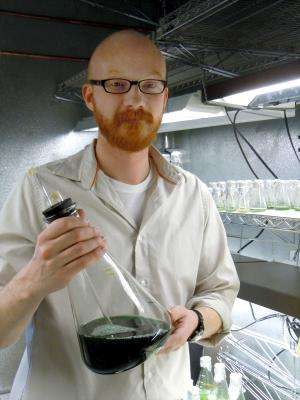Natural citrus scent may produce renewable solvents, fuel

(Phys.org) —A natural citrus scent called limonene may be the key to sustainability when it comes to making fragrances, solvents and perhaps even jet fuel, according to South Dakota State University doctoral student Charles Halfmann.
The Luverne, Minnesota, native has been working with associate professor Ruanbao Zhou of the SDSU Department of Biology and Microbiology to create genetically engineered cyanobacteria, commonly known as blue-green algae, that are capable of producing limonene.
Limonene is among a class of naturally emitted plant long-chain carbon chemicals called isoprenoids with biofuel potential.
A paper on his work has been published in Green Chemistry, a journal that features research on sustainable technologies. His work is supported by the Sun Grant Initiative, which promotes collaboration among researchers from land-grant institutions, government agencies and the private sector to develop bio-based transportation fuels.
Making limonene
Anything in the grocery store with an orange or lime scent contains limonene, according to Halfmann. Limonene, a 10-carbon molecule, is the main component in orange oil.
After squeezing the juice from the oranges, the rinds are ground and the oil is harvested through a distillation process that uses petroleum. This extraction process consumes energy and produces greenhouse gases, he explained.
Halfmann proposes using genetically engineering cyanobacteria to directly convert carbon dioxide, water and sunlight into limonene. The separation process would be simpler because the cyanobacteria emit the substance like a fragrance. "That's really an attractive feature," he said.
Beginning in 2012, Halfmann took a wild type of cyanobacteria and inserted a gene from the Sitka spruce tree to make it to produce limonene. He and other SDSU researchers envision using carbon dioxide and possibly even wastewater—byproducts of the ethanol industry—to produce green chemicals and biofuel.
However, Halfmann admits, "the technology is in its infancy." Scientists need to know more about the metabolic pathways and the mechanisms that regulate them to increase limonene production. To do this, researchers overexpress specific proteins.
Increasing production
The Green Chemistry article describes how Halfmann targeted three key enzymes in the natural production pathway identified as possibly limiting limonene production. By overexpressing these enzymes and increasing the amount of light available for photosynthesis, he was able to obtain close to a sevenfold increase in production.
The experiments were done in the lab, but Halfmann sees even greater potential using sunlight. "The amount of light from artificial lighting is vastly lower than from the natural sun at midday in summer," he pointed out. That is something he hopes to accomplish through his doctoral research.
Journal information: Green Chemistry
Provided by South Dakota State University
















